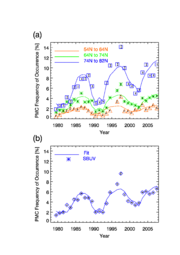Project 3 PMC/NLC altitude, frequency and brightness changes related to changes in dynamics and chemical composition
From CAWSES
Gary.thomas (Talk | contribs) m (→Introduction) |
Gary.thomas (Talk | contribs) m (→Activities (Projects, Campaigns, etc.)) |
||
| Line 20: | Line 20: | ||
==Activities (Projects, Campaigns, etc.)== | ==Activities (Projects, Campaigns, etc.)== | ||
| - | Suggestions are welcome from the project members and any interested scientists and students | + | Suggestions are welcome from the project members and any interested scientists and students. Please click on the discussion page if you would like to prompt responses and discussion |
Revision as of 23:21, 19 March 2010
- Project leaders: G.Thomas (USA), U.Berger (Germany)
- Project members:M. DeLand (USA, , B. Karlsson (Sweden), S. Kirkwood (Sweden), A. Klekociuk (Australia), A. Merkel (USA), N. Pertsev (Russia)
Contents |
Introduction
The 20-yr old speculation that high-altitude summertime ice clouds (polar mesospheric clouds or noctilucent clouds, here denoted MC) are affected by anthropogenic activities has recently received support from a 30-year time series of SBUV (Solar Backscatter Ultraviolet) satellite measurements (see Figure 1). SBUV data reveal a significant trend in bright MC properties. However, the robustness of the trend, extracted from interannual, local-time and solar-cycle variability, and its underlying causes remains debatable. It is important to understand the relative roles of these three factors (solar, inter-annual and long-term forcing) before a definitive long-term trend can be evaluated. Furthermore the problem of attribution, that is, the nature of the various forcings on ice formation is not yet understood. For example with respect to the long-term changes, is a lowered temperature due to higher carbon dioxide responsible for the observed increase in brightness and occurrence frequency of MC? Or are water vapor changes due to oxidation of methane responsible, since we know that lower atmospheric methane has more than doubled over the past 120 years, and methane oxidation leads to upper atmospheric water vapor. The failure to detect any changes in the altitude of MC since the first measurement made by Otto Jesse in the late nineteenth century has provided an important constraint, since water vapor changes and temperature changes affect cloud altitude in different ways. Fortunately, the state of the art in modeling has now reached a point where ice formation is coupled with general circulation models. Recent results are reported in the references below:

References
- Luebken, F.-J., U. Berger, and G. Baumgarten (2009), Stratospheric and solar cycle effects on long-term variability of mesospheric ice clouds, J. Geophys. Res., 114, D00I06, doi:10.1029/2009JD012377
- Merkel, A. W., Marsh, D. R., Gettelman, A., and Jensen, E. J.: On the relationship of polar mesospheric cloud ice water content, particle radius and mesospheric temperature and its use in multi-dimensional models, Atmos. Chem. Phys., 9, 8889-8901, 2009
- Merkel, A. W., D. Marsh, G. E. Thomas, C. Bardeen, M. Deland, WACCM simulations of long-term changes in polar mesospheric clouds, Layered Phenomenon in Mesospheric Regions (LPMR) Conference, Stockholm, 2009
- Marsh, D and A. W. Merkel, 30-year PMC variability modeled by WACCM, SA33B-08, Fall AGU Meeting, San Francisco, 2009
- Shettle,E. P.,M. T. DeLand, G. E. Thomas, and J. J. Olivero (2009), Long term variations in the frequency of polar mesospheric clouds in the Northern Hemisphere from SBUV, Geophys. Res. Lett., 36, L02803, doi:10.1029/2008GL036048.
Workshops and Meetings
The first workshop under the auspices of this working group was held in Boulder, Colorado on December 10 & 11, 2010, entitled Modeling Trends in mesospheric clouds. A short meeting report will be published: Reference: December 2009 PMC Trend Meeting Report entitled Mesospheric ice clouds as indicators of upper atmosphere climate change, accepted by EOS, publication date April 2010
In addition, The 6th IAGA/ICMA/CAWSES workshop on “Long-Term Changes and Trends in the Atmosphere” ( HYPERLINK "http://www.hao.ucar.edu/TREND2010/index.php" http://www.hao.ucar.edu/TREND2010/index.php) will be held at National Center for Atmospheric Research (NCAR) Center Green Conference Center, Boulder, Colorado, USA, June15-18, 2010, the week before the 2010 CEDAR (Coupling, Energetics, and Dynamics of Atmospheric Regions) workshop, which will also be held in Boulder.
Activities (Projects, Campaigns, etc.)
Suggestions are welcome from the project members and any interested scientists and students. Please click on the discussion page if you would like to prompt responses and discussion
